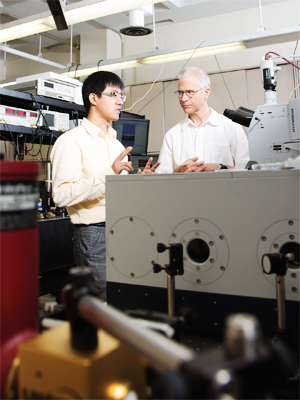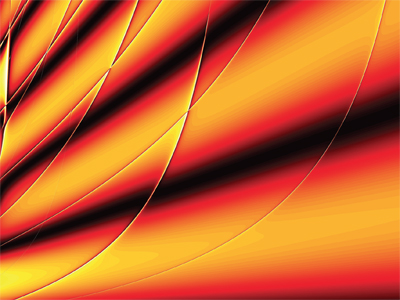Michael Weinstein + Nanfang Yu: Smooth Surfing of Optical Waves
Smooth Surfing of Optical Waves

Nanfang Yu (left) and Michael Weinstein in Yu’s optics lab.
(Photo by Jeffrey Schifman)
Solitary ocean waves ridden by surfers eventually break, but there are optical waves that travel along interfaces and are able to glide smoothly around and through rough environments without distortion.
This unusual class of optical waves is the focus of an ongoing collaboration between Michael Weinstein, professor of applied mathematics, and Nanfang Yu, assistant professor of applied physics.
Weinstein, who has a joint appointment as a professor of mathematics in the Department of Mathematics, and James Lee-Thorp, his student, recently obtained mathematical results on the existence and properties of “topologically protected edge states’’ in structures whose material spatial variations have special symmetries. According to Weinstein, “An edge state manifests itself as a surface wave propagating along a structured surface between two distinct media. What is remarkable is that these guided waves do not spread out or decay in amplitude, even in the presence of strong perturbations.”
Yu pointed out that “this robustness is a highly desirable feature for information transfer in ‘optical integrated circuits,’ and it is very compelling for us as device physicists to investigate physical realizations of these robust edge states.”

Reflection spectra of bonding and antibonding perturbation resonances in a symmetry broken periodic silicon nanostructure with varying height.
(Image courtesy of Adam Overvig)
Telecommunication relies on reliable transfer of light from one location to another. On a chip, this is impeded by factors such as inaccuracy of device geometry due to fabrication errors, varying operation conditions of the chip, and defects introduced to the chip while it is in use. Yu and Weinstein remark that the optical edge states they are studying promise to have fewer issues of this sort, and therefore offer an improved platform and can serve as a fundamental building block with which to create robust on-chip photonic devices.
“This is an exciting collaboration between mathematical theory and experiment,” said Weinstein. “Mathematicians and physicists naturally come at questions from different angles, so one is always learning and also being challenged to communicate one’s own perspective.”
Added Yu, “Weinstein’s group predicted the existence of a robust guided optical wave in a nonobvious structure, which physicists and engineers in the photonics community would be very unlikely to invent or study otherwise.”
“Nanfang Yu and his student Adam Overvig are outstanding device physicists and experimentalists in photonics. They have the expertise to design and realize novel device functionalities by choosing the right materials systems, and a device architecture that is feasible for nanofabrication,” said Weinstein. Together, the two research groups have a very broad toolset to demonstrate and explore modes of robust energy transport, and to develop mathematical and experimental approaches that can be used well beyond the current problems.
Weinstein and Yu’s research on optical “topologically protected” edge states is closely related to “topological insulators,” a field of intense fundamental and applied scientific activity. Their collaborative effort is supported by the National Science Foundation, the Air Force Office of Scientific Research, and the Simons Foundation.
